《药理学》课程教学资源(教材讲义,英文版)药理学教材讲义(共六部分,四十一章)
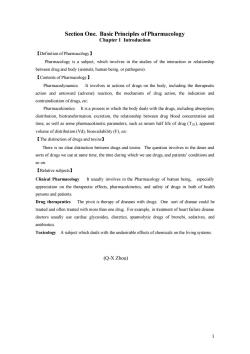
Section One.Basic Principles of Pharmacology Chapter 1 Introduction 【Definition of Pharmacology】 Pharmacology is a subject,which involves in the studies of the interaction or relationship between drug and body (animals,human being.or pathogens). 【Contents of Pharmacology】 Pharmacodynamics It involves in actions of drugs on the body,including the therapeutic action and untoward (adverse)reaction,the mechanism of drug action,the indication and corndiio ofrugs Pharmacokinetics It is a process in which the body deals with the drugs,including absorption, distribution.biotransformationexcretion the relationship betweenrug blood concentration and time,as well as some pharmacokinetic parameters,such as serum half life of drug (T),apparent volume of distribution(Vd),bioavailability (F), 【The distinction of drugs and toxins】 There is no clear distinction between drugs and toxins.The question involves in the doses and sorts of drugs we use at same time,the time during which we use drugs,and patients'conditions and so on. 【Relative subjects】 Clinical Pharmacology It usually involves in the Pharmacology of human being.especially appreciation on the therapeutic effects,pharmacokinetics,and safety of drugs in both of health persons and patients Drug therapeutics The pivot is therapy of diseases with drugs.One sort of disease could be treated and often treated with more than one drug For example,in reatment of heart failure disease doctors usuallyuse cardiac glycosides,diuretics.spasmolytic drugs of bronchi,sedatives,and antibiotics. A subject which deals with the undesirable effects of chemicals on the living systems (Q-X Zhou)
1 Section One. Basic Principles of Pharmacology Chapter 1 Introduction 【Definition of Pharmacology】 Pharmacology is a subject, which involves in the studies of the interaction or relationship between drug and body (animals, human being, or pathogens). 【Contents of Pharmacology】 Pharmacodynamics It involves in actions of drugs on the body, including the therapeutic action and untoward (adverse) reaction, the mechanism of drug action, the indication and contraindication of drugs, etc. Pharmacokinetics It is a process in which the body deals with the drugs, including absorption, distribution, biotransformation, excretion, the relationship between drug blood concentration and time, as well as some pharmacokinetic parameters, such as serum half life of drug (T1/2), apparent volume of distribution (Vd), bioavailability (F), etc. 【The distinction of drugs and toxins】 There is no clear distinction between drugs and toxins. The question involves in the doses and sorts of drugs we use at same time, the time during which we use drugs, and patients’ conditions and so on. 【Relative subjects】 Clinical Pharmacology It usually involves in the Pharmacology of human being, especially appreciation on the therapeutic effects, pharmacokinetics, and safety of drugs in both of health persons and patients. Drug therapeutics The pivot is therapy of diseases with drugs. One sort of disease could be treated and often treated with more than one drug. For example, in treatment of heart failure disease doctors usually use cardiac glycosides, diuretics, spasmolytic drugs of bronchi, sedatives, and antibiotics. Toxicology A subject which deals with the undesirable effects of chemicals on the living systems. (Q-X Zhou)
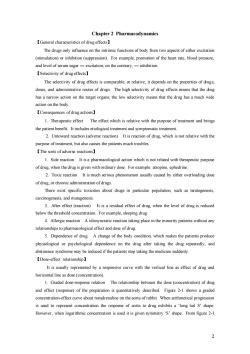
Chapter 2 Pharmacodynamics 【General characteristics of drug effects】? The drugs only influence on the intrinsic functions of body from two aspects of either excitation (stimulation)inhibtion(suppresion).For example the heart rate,blod pressure, and level of serum sugar-excitation:on the contrary,-inhibition. 【Selectivity of drug effects】? doses,and administrative routes of drugs.The high selectivity of drug effects means that the drug has a narrow action on the target organs,the low selectivity means that the drug has a much wide action on the body. 【Consequences of drug actions】 1.Therapeutic effect The effect which is relative with the purpose of treatment and brings the patient benefit.It includes etiological treatment and symptomatic treatment. 2 Untoward reaction(adverse reaction)It is reaction of drug.which isnot relative with the purpose of treatment,but also causes the patients much troubles. 【The sorts reactions】 1.Side reaction It is a pharmacological action which is not related with therapeutic purpose of drug.when the drug is given with ordinary dose.For example:atropine,ephedrine. 2.Toxic reaction It is much serious phenomenon usually caused by either overloading dose of drug.or chronic administration of drugs. There exist specific toxicities about drugs in particular population,such as teratogenesis carcinogenesis,and mutagenesis. 3.After effect (reaction)It is a residual effect of drug when the level of drug is reduced below the threshold concentration.For example,sleeping drug. 4.Allergic reaction Aidiosyncratic eaction taking place inthe minority patients without any relationships to pharmacological effect and dose of drug. 5.Dependence of drug change of the body condition,which makes the patients produce physiological or pychological dependence on the drug afer taking the drug repeatedy.and abstinence syndrome may be induced if the patients stop taking the medicine suddenly. It is usually represented by a responsive curve with the vertical line as effect of drug and horizontal ne(). 1.Graded dose-response relation The relationship between the dose(concentration)of drug and effect(response)of the preparation is quantitatively described.Figure 2-1 shows a graded concentration-effect curve about noradrenaline on the aorta of rabbit When arithmetical progression is used to represent concentration the response of aorta to drug exhibits a 'long tail S'shape. However,when logarithmic concentration is used it is given symmetryS'shape.From figure 2-1 2
2 Chapter 2 Pharmacodynamics 【General characteristics of drug effects】 The drugs only influence on the intrinsic functions of body from two aspects of either excitation (stimulation) or inhibition (suppression). For example, promotion of the heart rate, blood pressure, and level of serum sugar — excitation; on the contrary, — inhibition. 【Selectivity of drug effects】 The selectivity of drug effects is comparable, or relative; it depends on the properties of drugs, doses, and administrative routes of drugs. The high selectivity of drug effects means that the drug has a narrow action on the target organs; the low selectivity means that the drug has a much wide action on the body. 【Consequences of drug actions】 1. Therapeutic effect The effect which is relative with the purpose of treatment and brings the patient benefit. It includes etiological treatment and symptomatic treatment. 2. Untoward reaction (adverse reaction) It is reaction of drug, which is not relative with the purpose of treatment, but also causes the patients much troubles. 【The sorts of adverse reactions】 1. Side reaction It is a pharmacological action which is not related with therapeutic purpose of drug, when the drug is given with ordinary dose. For example: atropine, ephedrine. 2. Toxic reaction It is much serious phenomenon usually caused by either overloading dose of drug, or chronic administration of drugs. There exist specific toxicities about drugs in particular population, such as teratogenesis, carcinogenesis, and mutagenesis. 3. After effect (reaction) It is a residual effect of drug, when the level of drug is reduced below the threshold concentration. For example, sleeping drug. 4. Allergic reaction A idiosyncratic reaction taking place in the minority patients without any relationships to pharmacological effect and dose of drug. 5. Dependence of drug A change of the body condition, which makes the patients produce physiological or psychological dependence on the drug after taking the drug repeatedly, and abstinence syndrome may be induced if the patients stop taking the medicine suddenly. 【Dose-effect relationship】 It is usually represented by a responsive curve with the vertical line as effect of drug and horizontal line as dose (concentration). 1. Graded dose-response relation The relationship between the dose (concentration) of drug and effect (response) of the preparation is quantitatively described. Figure 2-1 shows a graded concentration-effect curve about noradrenaline on the aorta of rabbit. When arithmetical progression is used to represent concentration the response of aorta to drug exhibits a ‘long tail S’ shape. However, when logarithmic concentration is used it is given symmetry ‘S’ shape. From figure 2-1
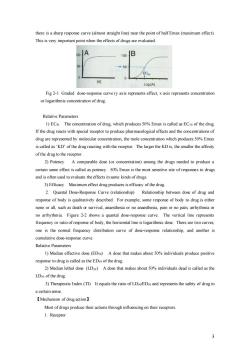
there is a sharp response curve (almost straight line)near the point of half Emax(maximum effect). This is very important point when the effects of drugsare evaluated. 50 LogI闪 Fig2-1 Graded dose-response curve(y axis represents effect,x axis represents concentration or logarithmic concentration of drug Relative Parameters 1)ECso The concentration of drug.which produces 50%Emax is called as ECso of the drug If the drug reacts with special receptor to produce pharmacological effects and the concentrations drug are represented by molecular concentration.the mole concentration which produces 50%Emax is called asKDof the drug reacting with the receptor.The larger the KDis,the smaller the affinity of the drug to the receptor. 2)Potency A comparable dose (or concentration)among the drugs needed to produce a certain same effect is called as potency.%Emax is the most sensitive site of responses to drugs and is often used to evaluate the effects in same kinds of drugs. 3)Efficacy Maximum effect drug produces is efficacy of the drug 2.Quantal Dose-Response Curve (relationship)Relationship between dose of drug and respons of body is qualitatively described.For of body to drug is either none or all,such as death or survival,anaesthesia or no anaesthesia,pain or no pain,amhythmiaor no arrhythmia.Figure 2-2 shows a quantal dose-response curve.The vertical line represents frequency or ratio of response of body,the horizontal line is logarithmic dose.There are two curves, one is the nommal frequency distribution curve of dose-response relationship.and another is cumulative dose-response curve Relative Parameters 1)Median effective dose(EDso)A dose that makes about 0%individuals produce positive response to drug is called as the EDso of the drug. 2)Median lethal dose (LDso)A dose that makes about 50%individuals dead is called as the LDso of the drug 3)Therapeutic Index (T)It equals the ratio of LD/EDs and represents the safety of drug in a certain sense. 【Mechanism of drug action】 Most of drugs produce their actions through influencing on their receptors 1.Receptor
3 there is a sharp response curve (almost straight line) near the point of half Emax (maximum effect). This is very important point when the effects of drugs are evaluated. Fig 2-1 Graded dose-response curve (y axis represents effect, x axis represents concentration or logarithmic concentration of drug. Relative Parameters 1) EC50 The concentration of drug, which produces 50% Emax is called as EC50 of the drug. If the drug reacts with special receptor to produce pharmacological effects and the concentrations of drug are represented by molecular concentration, the mole concentration which produces 50% Emax is called as ‘KD’ of the drug reacting with the receptor. The larger the KD is, the smaller the affinity of the drug to the receptor. 2) Potency A comparable dose (or concentration) among the drugs needed to produce a certain same effect is called as potency. 50% Emax is the most sensitive site of responses to drugs and is often used to evaluate the effects in same kinds of drugs. 3) Efficacy Maximum effect drug produces is efficacy of the drug. 2. Quantal Dose-Response Curve (relationship) Relationship between dose of drug and response of body is qualitatively described. For example, some response of body to drug is either none or all, such as death or survival, anaesthesia or no anaesthesia, pain or no pain, arrhythmia or no arrhythmia. Figure 2-2 shows a quantal dose-response curve. The vertical line represents frequency or ratio of response of body, the horizontal line is logarithmic dose. There are two curves, one is the normal frequency distribution curve of dose-response relationship, and another is cumulative dose-response curve. Relative Parameters 1) Median effective dose (ED50) A dose that makes about 50% individuals produce positive response to drug is called as the ED50 of the drug. 2) Median lethal dose (LD50) A dose that makes about 50% individuals dead is called as the LD50 of the drug. 3) Therapeutic Index (TI) It equals the ratio of LD50/ED50 and represents the safety of drug in a certain sense. 【Mechanism of drug action】 Most of drugs produce their actions through influencing on their receptors. 1. Receptor
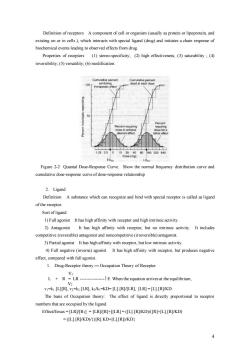
Definition of receptors A component of cell or organism(usually as protein or lipoprotein,and existing onor),which interacts with special ligand (drug)and initiates a chain response of biochemical events leading to observed effects from drug. Properties of receptors (1)stereo-specificity.(2)high effectiveness.(3)saturability:(4) reversibility:(5)versatilitv:(6)modification. 12s250,09 80 032064 ED. Figure 2-2 Quantal Dose-Response Curve.Show the normal frequency distribution curve and cumulative dose-response curve of dose-response relationship 2.Ligand Definition A substance which can recognize and bind with special receptor is called as ligand ofthe receptor. Sort of ligand 1)Full agonist It has high affinity with receptor and high intrinsic activity 2)Antagonist It has high affinity with receptor,but no intrinsic activity.It includes competitive (reversible)antagonist and noncompetitive(irreversible)antagonist. 3)Partial agonist It has high affinity with receptor,but low intrinsic activity. 4)Full negative(inverse)agonist It has high affinity with receptor,but produces negative effect.compared with full agonist. 1.Drug-Receptor theory-Occupation Theory of Receptor L+R LR- -E When the equation arrives at the equilibrium, v=k1.[L][R].vz=k2.[LR].kz/ky=KD=[L].[Rl/[LR].[LR]=[L].[R]/KD. The basis of Occupation theory:The effect of ligand is directly proportional to receptor numbers that are occupied by the ligand. Effect/Emax=[LRVIR]=[LR]/IR]+[[LR]=([L].[R]/KD)/([R]+[L].[R]/KD) =([L][R]/KD)/(([R].KD+[L][R]/KD)
4 Definition of receptors A component of cell or organism (usually as protein or lipoprotein, and existing on or in cells ), which interacts with special ligand (drug) and initiates a chain response of biochemical events leading to observed effects from drug. Properties of receptors (1) stereo-specificity; (2) high effectiveness; (3) saturability ; (4) reversibility; (5) versatility; (6) modification. Figure 2-2 Quantal Dose-Response Curve. Show the normal frequency distribution curve and cumulative dose-response curve of dose-response relationship 2. Ligand Definition A substance which can recognize and bind with special receptor is called as ligand of the receptor. Sort of ligand 1) Full agonist It has high affinity with receptor and high intrinsic activity. 2) Antagonist It has high affinity with receptor, but no intrinsic activity. It includes competitive (reversible) antagonist and noncompetitive (irreversible) antagonist. 3) Partial agonist It has high affinity with receptor, but low intrinsic activity. 4) Full negative (inverse) agonist It has high affinity with receptor, but produces negative effect, compared with full agonist. 1. Drug-Receptor theory — Occupation Theory of Receptor V1 L + R = LR - E When the equation arrives at the equilibrium, V2 v1=k1.[L][R], v2=k2.[LR], k2/k1=KD= [L].[R]/[LR], [LR] = [L].[R]/KD. The basis of Occupation theory: The effect of ligand is directly proportional to receptor numbers that are occupied by the ligand. Effect/Emax = [LR]/[RT] = [LR]/[R]+[[LR] = ([L].[R]/KD)/([R]+[L].[R]/KD) = ([L].[R]/KD)/{([R].KD+[L].[R])/KD}
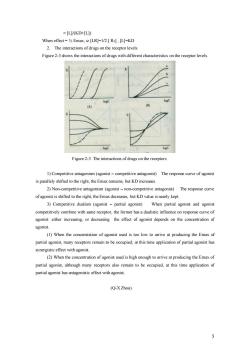
=IL(KD+ILI) When effect=/.Emax.ie[LR]=1/2.[R].[L]=KD 2.The interactions of drugs on the receptor levels Figure2-3 shows the interactions of drugs with different characteristics on the receptor levels Figure2-3 The interactions of drugs on the receptors 1)Competitive antagonism(agonist-competitive antagonist)The response curve of agonist is parallely shifted to the right,the Emax remains,but KD increases. 2)Non-competitive antagonism (agonist-non-competitive antagonist)The response curve of agonist is shifted to the right,the Emax decreases but KD value is nearly kept 3)Competitive dualism (agonist-partial agonist)When partial agonist and agonist competitively combine with same receptor,the former has a dualistic influence on response curve of agonist:either increasing,or decreasing the effect of agonist depends on the concentration of (1)When the concentration of agonist used is too low to arrive at producing the Emax of partial agonist,many receptors remain to be occupied:at this time application of partial agonist has synergistic effect with agonist. (2)When the concentration of agonist used is high enough toarrive at producing the Emax of partial agonist,although many receptors also remain to be occupied,at this time application of partial agonist has antagonistic effect with agonist. (Q-X Zhou)
5 = [L]/(KD+[L]) When effect = ½.Emax, ie [LR]=1/2.[ RT] , [L]=KD 2. The interactions of drugs on the receptor levels Figure 2-3 shows the interactions of drugs with different characteristics on the receptor levels. Figure 2-3 The interactions of drugs on the receptors 1) Competitive antagonism (agonist – competitive antagonist) The response curve of agonist is parallely shifted to the right, the Emax remains, but KD increases. 2) Non-competitive antagonism (agonist – non-competitive antagonist) The response curve of agonist is shifted to the right, the Emax decreases, but KD value is nearly kept. 3) Competitive dualism (agonist – partial agonist) When partial agonist and agonist competitively combine with same receptor, the former has a dualistic influence on response curve of agonist: either increasing, or decreasing the effect of agonist depends on the concentration of agonist. (1) When the concentration of agonist used is too low to arrive at producing the Emax of partial agonist, many receptors remain to be occupied; at this time application of partial agonist has synergistic effect with agonist. (2) When the concentration of agonist used is high enough to arrive at producing the Emax of partial agonist, although many receptors also remain to be occupied, at this time application of partial agonist has antagonistic effect with agonist. (Q-X Zhou)
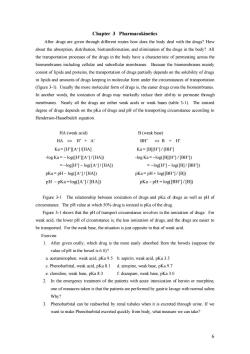
Chapter 3 Pharmacokinetics After drugs are given through different routes how does the body deal with the drugs?How about the absorption distribution,biotransformtion and elimination of the drugs in the body?All the transportation processes of the drugs in the body have a characteristic of permeating across the biomembranes including cellular and subcellular membranes.Because the biomembranes mainly consist of lipids and proteins,the transportation of drugs partially depends on the solubility of drugs in lipids and amounts of drugs keeping in form under the circumstances of transportation (figure 3-1).Usually the more molecular form of drugs is,the easier drugs cross the biomembranes. In another words,the ionization of drugs may markedly reduce their ability to permeate through membranes.Nearly all the drugs are either weak acids or weak bases (table 3-1).The ionized degree of drugs depends on the pKa of drugs and pH of the transporting circumstance according to Henderson-Hasselbalch equation. HA (weak acid) B(weak base) HA台H+A BH÷B+H Ka=[H']A-]/THA] Ka=BH]/BH的 -log Ka=-log([H][A-]/[HA]) -logKa=-log([B][H]/[BH']) =-log[H']-log([A-]/[HAJ) =-log[H*]-log([B]/[BH"]) pKa=pH-log([A-]/[HA]) pKa=pH+log([BH]/[B]) pH -pKa=log([A-]/[HA]) pKa-pH=log([BH+]/[B]) Figure 3-1 The relationship between ionization of drugs and pKa of drugs as well as pH of circumstance.The pH value at which 50%drug is ionized is pKa of the drug Figure 3-1 shows that the pH of transport circumstance involves in the ionization of drugs.For weak acid,the lower pH of circumstance is,the less ionization of drugs,and the drugs are easier to be transported.For the weak base,the situation is just opposite to that of weak acid. Exercise 1.After given orally,which drug is the most easily absorbed from the bowels(suppose the value of pH in the bowel is6.0)? a.acetaminophen,weak acid,pKa 9.5 b.aspirin,weak acid,pKa3.5 c.Phenobarbital,weak acid,pKa8.1 d.atropine,weak base,pKa9.7 e.clonidine,weak base,pKa 8.3 f.diazepam,weak base,pKa3.0 2.In the emergency treatment of the patients with acute intoxication of heroinor morphine one of measures taken is that the patients are performed by gastric lavage with normal saline Why? 3.Phenobarbital can be reabsorbed by renal tubules when it is excreted through urine.If we want to make Phenobarbital excreted quickly from body,what measure we can take? 6
6 Chapter 3 Pharmacokinetics After drugs are given through different routes how does the body deal with the drugs? How about the absorption, distribution, biotransformation, and elimination of the drugs in the body? All the transportation processes of the drugs in the body have a characteristic of permeating across the biomembranes including cellular and subcellular membranes. Because the biomembranes mainly consist of lipids and proteins, the transportation of drugs partially depends on the solubility of drugs in lipids and amounts of drugs keeping in molecular form under the circumstances of transportation (figure 3-1). Usually the more molecular form of drugs is, the easier drugs cross the biomembranes. In another words, the ionization of drugs may markedly reduce their ability to permeate through membranes. Nearly all the drugs are either weak acids or weak bases (table 3-1). The ionized degree of drugs depends on the pKa of drugs and pH of the transporting circumstance according to Henderson-Hasselbalch equation. HA (weak acid) B (weak base) HA H+ + A− BH+ B + H+ Ka = [H+ ][A− ] /[HA] Ka = [B][H+ ] / [BH+ ] -log Ka = − log([H+ ][A− ] / [HA]) -log Ka = −log([B][H+ ] / [BH+ ]) = −log[H+ ] − log([A− ] / [HA]) = −log[H+ ] − log([B] / [BH+ ]) pKa = pH − log([A− ] / [HA]) pKa = pH + log([BH+ ] / [B]) pH − pKa = log([A− ] / [HA]) pKa − pH = log([BH+ ] / [B]) Figure 3-1 The relationship between ionization of drugs and pKa of drugs as well as pH of circumstance. The pH value at which 50% drug is ionized is pKa of the drug. Figure 3-1 shows that the pH of transport circumstance involves in the ionization of drugs. For weak acid, the lower pH of circumstance is, the less ionization of drugs, and the drugs are easier to be transported. For the weak base, the situation is just opposite to that of weak acid. Exercise 1. After given orally, which drug is the most easily absorbed from the bowels (suppose the value of pH in the bowel is 6.0)? a. acetaminophen, weak acid, pKa 9.5 b. aspirin, weak acid, pKa 3.5 c. Phenobarbital, weak acid, pKa 8.1 d. atropine, weak base, pKa 9.7 e. clonidine, weak base, pKa 8.3 f. diazepam, weak base, pKa 3.0 2. In the emergency treatment of the patients with acute intoxication of heroin or morphine, one of measures taken is that the patients are performed by gastric lavage with normal saline. Why? 3. Phenobarbital can be reabsorbed by renal tubules when it is excreted through urine. If we want to make Phenobarbital excreted quickly from body, what measure we can take?

Table 3-1 the pKa of some drugs Weak acids pKa Weak base pKa Acetaminophen 9.5 Amphetamine 9.8 Ampicillin 2.5 Atropine 97 Aspirin 3.5 Chloroquin 10.884* Chlorothiazide 6.8.9.4 Chlorpromazine 9.3 Ciprofloxacin 6.,8.7 Clonidine 83 Furosemide 3.9 Codeine 8.5 Methotrexate 48 Desipramine 10.2 Phenobarbital 8.1 Diazepam 3.0 Propylthiouracil 8.3 Ephedrine 96 Sulfadiazine 65 Propranolol 9.4 Theophylline 8.8 Quinidine 8.5,4.4 Tolbutamide 53 Scopolamine 81 Warfarin 50 Terbutaline 10.1 Tolazoline 10.6 More than one ionization group 【Division of drug transportation】 1.Passive transport It includes filtration.facilitation diffusion.and simple diffusion.Among them.the simple diffusion is the most mportant way through which most in the body.In this transport way,drugs across the biomembranes are driven by the drug concentration gradient existingon two sides of the transport regions.Therefore.no consumption of energy and no carrier are needed during the period of drug transport. 2.Active transport This is not important transport way because very few drugs transport across membrane by this way.When drugs are transported by this way it is necessary for consumption of energy and special carriers 【Absorption】 1.Definition A process,in which drug enters the blood stream from the sites of administration. For example,drugs are absorbed from gastrointestinal tract().subcutaneous tissue. intramuscular sites.or other parenteral routes. 2.The factors that influence on the absorption of drugs 1)The factors from drugs Physical and chemical properties of drugs:molecular size and shape. pKa,solubility, 2)The factors from preparations:Powder,pill,tablet,injection.patchfim, 3)Manufacture technology:Particle size,salt form,crystal polymorphism,density,degree of disintegration,the presence of excipients, 4)The circumstance of absorption:pH,Blood flow,area of absorption
7 Table 3-1 the pKa of some drugs Weak acids pKa Weak base pKa Acetaminophen 9.5 Amphetamine 9.8 Ampicillin 2.5 Atropine 9.7 Aspirin 3.5 Chloroquine 10.8, 8.4* Chlorothiazide 6.8, 9.4* Chlorpromazine 9.3 Ciprofloxacin 6.1, 8.7* Clonidine 8.3 Furosemide 3.9 Codeine 8.5 Methotrexate 4.8 Desipramine 10.2 Phenobarbital 8.1 Diazepam 3.0 Propylthiouracil 8.3 Ephedrine 9.6 Sulfadiazine 6.5 Propranolol 9.4 Theophylline 8.8 Quinidine 8.5, 4.4* Tolbutamide 5.3 Scopolamine 8.1 Warfarin 5.0 Terbutaline 10.1 Tolazoline 10.6 * More than one ionization group 【Division of drug transportation】 1. Passive transport It includes filtration, facilitation diffusion, and simple diffusion. Among them, the simple diffusion is the most important way through which most of drugs are transported in the body. In this transport way, drugs across the biomembranes are driven by the drug concentration gradient existing on two sides of the transport regions. Therefore, no consumption of energy and no carrier are needed during the period of drug transport. 2. Active transport This is not important transport way because very few drugs transport across membrane by this way. When drugs are transported by this way it is necessary for consumption of energy and special carriers. 【Absorption】 1. Definition A process, in which drug enters the blood stream from the sites of administration. For example, drugs are absorbed from gastrointestinal tract (per os, orally), subcutaneous tissue, intramuscular sites, or other parenteral routes. 2. The factors that influence on the absorption of drugs 1) The factors from drugs Physical and chemical properties of drugs: molecular size and shape, pKa, solubility, . 2) The factors from preparations: Powder, pill, tablet, injection.patch film, . 3) Manufacture technology: Particle size, salt form, crystal polymorphism, density, degree of disintegration, the presence of excipients, . 4) The circumstance of absorption: pH, Blood flow, area of absorption,
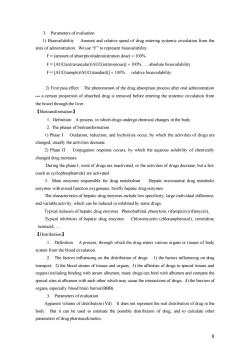
3.Parameters of evaluation 1)Bioavailability Amount and relative speed of drug entering systemic circulation from the sites of administration.Weuse""to represent bioavailability. F=(amount of absorption/administration dose)10 F=[AUC(extravascular)/AUC(intravenous)]x100% F=[AUC(sample)/AUC(standard)]100%.relative bioavailability 2)First pass effect The phenomenon of the drug absorption process after oral administration -a certain proportion of absorbed drug is removed before entering the systemic circulation from the bowel through the live 【Biotransformation】 1.Definition A process,in which drugs undergo chemical changes in the body. 2.The phases of biotransformation 1)Phase I Oxidation,reduction,and hydrolysis occur,by which the activities of drugs are changed,usually the activities decrease 2)Phase II Conjugation response occurs,by which the aqueous solubility of chemically changed drug increases During the phase most of drugs are inactivated,or the activities of drugs decrease,but a few (such as cyclophosphamide)are activated 3.Main enzymes responsible for drug metabolism Hepatic microsomal drug metabolic enzymes with mixed function oxygenases,briefly hepatic drug enzymes. The characteristics of hepatic drug enzymes include low specificity,large individual difference, and variable activity,which can be induced or inhibited by some drugs Typical inducers ofhepatic drug enzymes Phenobarbital,phenytoin,rifampicin(ifamycin), Typical inhibitors of hepatic drug enzymes Chloromycetin (chloramphenicol),cimetidine, isoniazid. 【Distribution】 1.Definition A process,through which the drug enters various organs or tissues of body system from the blood circulation. 2.The factors influencing on the distribution of drugs 1)the factors influencing on drug transport 2)the bood stream of tissues and organs3)the affinities of drugs to special tissues and organs(including binding with serum albumen.many drugs can bind with albumen and compete the special sites at abmen with each other which may cause the interactions of)the barriers of organs,especially blood brain barrier(BBB). 3.Parameters of evaluation Apparent volume of distribution(Vd)It does not represent the real distribution of drug in the body.But it can be used to estimate the possible distribution of drug.and to calculate other parameters of drug pharmacokinetics
8 3. Parameters of evaluation 1) Bioavailability Amount and relative speed of drug entering systemic circulation from the sites of administration. We use “F” to represent bioavailability. F = (amount of absorption/administration dose) 100% F = [AUC(extravascular)/AUC(intravenous)] 100% . absolute bioavailability F = [AUC(sample)/AUC(standard)] 100% . relative bioavailability 2) First pass effect The phenomenon of the drug absorption process after oral administration ⎯ a certain proportion of absorbed drug is removed before entering the systemic circulation from the bowel through the liver. 【Biotransformation】 1. Definition A process, in which drugs undergo chemical changes in the body. 2. The phases of biotransformation 1) Phase Ι Oxidation, reduction, and hydrolysis occur, by which the activities of drugs are changed, usually the activities decrease. 2) Phase Π Conjugation response occurs, by which the aqueous solubility of chemically changed drug increases. During the phase Ι, most of drugs are inactivated, or the activities of drugs decrease, but a few (such as cyclophosphamide) are activated. 3. Main enzymes responsible for drug metabolism Hepatic microsomal drug metabolic enzymes with mixed function oxygenases, briefly hepatic drug enzymes. The characteristics of hepatic drug enzymes include low specificity, large individual difference, and variable activity, which can be induced or inhibited by some drugs. Typical inducers of hepatic drug enzymes Phenobarbital, phenytoin, rifampicin (rifamycin), Typical inhibitors of hepatic drug enzymes Chloromycetin (chloramphenicol), cimetidine, isoniazid, . 【Distribution】 1. Definition A process, through which the drug enters various organs or tissues of body system from the blood circulation. 2. The factors influencing on the distribution of drugs 1) the factors influencing on drug transport; 2) the blood stream of tissues and organs; 3) the affinities of drugs to special tissues and organs (including binding with serum albumen; many drugs can bind with albumen and compete the special sites at albumen with each other which may cause the interactions of drugs. 4) the barriers of organs, especially blood brain barrier(BBB). 3. Parameters of evaluation Apparent volume of distribution (Vd) It does not represent the real distribution of drug in the body. But it can be used to estimate the possible distribution of drug, and to calculate other parameters of drug pharmacokinetics
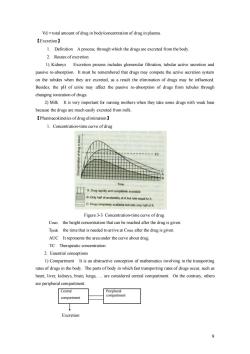
Vd=total amount of drug in body/concentration of drug in plasma 【Excretion】 1.Definition A process.through which the drugs are exereted from the body 2.Routes ofexcretion 1)Kidneys Exeretion process includes tubular active secretion and passive re-absorption.It must be remembered that drugs may compete the active secretion system on the tubules when they are excreted.as a result of drugs may be Besides,the pH of urine may affect the passive re-absorption of drugs from tubules through changing ionization of drugs 2)Milk It is very important for nursing mothers when they take some drugs with weak base because the drugs are much easily excreted from milk. 【Pharmacokinetics of drug elimination】 1.Concentration-time curve of drug C Drug competely avb but rate onyhatl ofA Figure 3-3 Concentration-time curve of drug Cmax the height concentration that can be reached after the drug is given. Tpeak the time that is needed torrive t Cm after the drug is given AUC It represents the area under the curve about drug. TC Therapeutic concentration 2.Essential conceptions 1)Compartment It is an abstractive conception of mathematics involving in the transporting rates of drugs in the body.The parts of body in which fast transporting rates of drugs occur,such as heart,liver,kidneys,brain lungs,are considered central compartment.On the contrary,others are peripheral compartment. Central compartment ↓ Excretion 9
9 Vd = total amount of drug in body/concentration of drug in plasma. 【Excretion】 1. Definition A process, through which the drugs are excreted from the body. 2. Routes of excretion 1) Kidneys Excretion process includes glomerular filtration, tubular active secretion and passive re-absorption. It must be remembered that drugs may compete the active secretion system on the tubules when they are excreted, as a result the elimination of drugs may be influenced. Besides, the pH of urine may affect the passive re-absorption of drugs from tubules through changing ionization of drugs. 2) Milk It is very important for nursing mothers when they take some drugs with weak base because the drugs are much easily excreted from milk. 【Pharmacokinetics of drug elimination】 1. Concentration-time curve of drug Figure 3-3 Concentration-time curve of drug Cmax the height concentration that can be reached after the drug is given. Tpeak the time that is needed to arrive at Cmax after the drug is given. AUC It represents the area under the curve about drug. TC Therapeutic concentration 2. Essential conceptions 1) Compartment It is an abstractive conception of mathematics involving in the transporting rates of drugs in the body. The parts of body in which fast transporting rates of drugs occur, such as heart, liver, kidneys, brain, lungs, . are considered central compartment. On the contrary, others are peripheral compartment. Excretion Central compartment Peripheral compartment
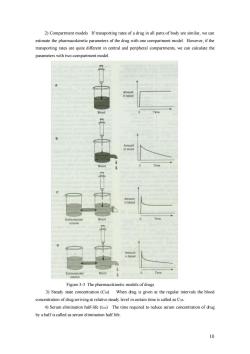
2)Compartment models If transporting rates of a drug in all parts of body are similar,we can estimate the pharmacokinetic parameters of the drug with one compartment model.However,if the transporting rates are quite different in central and peripheral compartments,we can calculate the parameters with two-compartment model. Time Figure 3-3 The pharmacokinetic models of drugs 3)Steady state concentration(Css)When drug is given at the regular intervals the blood concentration of drug arriving at relative steady level in certain time is called as Css. 4)Serum elimination half-life (The time required to reduce serum concentration ofrug by a half is called as serum elimination half life
10 2) Compartment models If transporting rates of a drug in all parts of body are similar, we can estimate the pharmacokinetic parameters of the drug with one compartment model. However, if the transporting rates are quite different in central and peripheral compartments, we can calculate the parameters with two-compartment model. Figure 3-3 The pharmacokinetic models of drugs 3) Steady state concentration (Css) When drug is given at the regular intervals the blood concentration of drug arriving at relative steady level in certain time is called as Css. 4) Serum elimination half-life (t1/2) The time required to reduce serum concentration of drug by a half is called as serum elimination half life
按次数下载不扣除下载券;
注册用户24小时内重复下载只扣除一次;
顺序:VIP每日次数-->可用次数-->下载券;
- 《药理学》课程教学实验指导书(共十四个实验).doc
- 《药理学》课程实验指导(讲义)实验7 传出神经系统药物对麻醉兔血压的作用.doc
- 《药理学》课程实验指导(讲义)实验6 传出神经系统药物对蟾蜍腹直肌的作用.doc
- 《药理学》课程实验指导(讲义)实验5 全血水杨酸钠二室模型药动学参数测定.doc
- 《药理学》课程实验指导(讲义)实验4 肝脏功能对药物作用的影响.doc
- 《药理学》课程实验指导(讲义)实验3 不同给药途径对药物作用的影响.doc
- 《药理学》课程实验指导(讲义)实验2 药物的基本作用.doc
- 《药理学》课程实验指导(讲义)实验1 实验动物的捉持法和给药法.doc
- 《药理学》课程授课教案(讲义)麻醉性镇痛药.doc
- 《药理学》课程授课教案(讲义)平喘药.doc
- 《药理学》课程授课教案(讲义)子宫用药.doc
- 《药理学》课程授课教案(讲义)抗甲亢.doc
- 《药理学》课程授课教案(讲义)抗组胺药.doc
- 《药理学》课程授课教案(讲义)抗糖尿病药.doc
- 《药理学》课程授课教案(讲义)抗慢性心功能不全.doc
- 《药理学》课程授课教案(讲义)抗生素.doc
- 《药理学》课程授课教案(讲义)镇痛解热镇痛.doc
- 《药理学》课程授课教案(讲义)肾上腺皮质激素药物.doc
- 《药理学》课程授课教案(讲义)强心药物.doc
- 《药理学》课程授课教案(讲义)利尿药物.doc
- 《药理学》课程教学课件(PPT讲稿)Thyroid and Antithyroid Drug.ppt
- 《药理学》课程教学资源(教材讲义,英文版)药理学教材讲义(Chapter 36 -41).doc
- 《药理学》课程教学课件(PPT讲稿)β-Lactam antibiotics.ppt
- 《药理学》课程教学课件(PPT讲稿)Section 1 Basic Principles of Pharmacology.ppt
- 《药理学》课程教学大纲 Teaching Outline for Pharmacological Course(英文).doc
- 《药理学》课程教学大纲 Teaching Outline for Pharmacological Course(中文).doc
- 《药理学》课程教学资源(试卷习题)examination paper A(含答案).doc
- 《药理学》课程教学资源(试卷习题)examination paper B(含答案).doc
- 《临床药理学》课程教学大纲 clinical pharmacology.doc
- 《临床药理学》课程考试大纲(clinical pharmacology).doc
- 《临床药理学》课程授课教案.doc
- 《临床药理学》课程试题试卷库(无答案).doc
- 《临床药理学》课程作业习题1(无答案).doc
- 《临床药理学》课程作业习题2(无答案).doc
- 《临床药理学》课程教学课件(PPT讲稿)病理讨论2.ppt
- 《临床药理学》课程教学课件(PPT讲稿)第三章 治疗药物监测和给药个体化.ppt
- 《临床药理学》课程教学课件(PPT讲稿)第一章 绪论(石河子大学:胡艳丽).ppt
- 《临床药理学》课程教学课件(PPT讲稿)第二章 临床药代动力学.ppt
- 《临床药理学》课程教学课件(PPT讲稿)第八章 新生儿及儿童用药.ppt
- 《临床药理学》课程教学课件(PPT讲稿)第七章 妊娠期和哺乳期妇女用药.ppt
